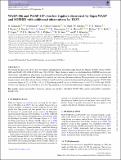WASP-186 and WASP-187 : two hot Jupiters discovered by SuperWASP and SOPHIE with additional observations by TESS
Abstract
We present the discovery of two new hot Jupiters identified from the Wide-Angle Search for Planets (WASP) survey, WASP-186b and WASP-187b (TOI-1494.01 and TOI-1493.01). Their planetary nature was established from SOPHIE spectroscopic observations, and additional photometry was obtained from Transiting Exoplanet Survey Satellite. Stellar parameters for the host stars are derived from spectral line, infrared flux method, and isochrone placement analyses. These parameters are combined with the photometric and radial velocity data in a Markov chain Monte Carlo method to determine the planetary properties. WASP-186b is a massive Jupiter (4.22 ± 0.18 MJ, 1.11 ± 0.03 RJ) orbiting a mid-F star on a 5.03-d eccentric (e = 0.327 ± 0.008) orbit. WASP-187b is a low-density (0.80 ± 0.09 MJ, 1.64 ± 0.05 RJ) planet in a 5.15-d circular orbit around a slightly evolved early F-type star.
Citation
Schanche , N , Hébrard , G , Collier Cameron , A , Dalal , S , Smalley , B , Wilson , T G , Boisse , I , Bouchy , F , Brown , D J A , Demangeon , O , Haswell , C A , Hellier , C , Kolb , U C , Lopez , T , Maxted , P F L , Pollacco , D L , West , R G & Wheatley , P J 2020 , ' WASP-186 and WASP-187 : two hot Jupiters discovered by SuperWASP and SOPHIE with additional observations by TESS ' , Monthly Notices of the Royal Astronomical Society , vol. 499 , no. 1 , pp. 428-440 . https://doi.org/10.1093/mnras/staa2848
Publication
Monthly Notices of the Royal Astronomical Society
Status
Peer reviewed
ISSN
0035-8711Type
Journal article
Description
NS acknowledges the support of NPRP grant #X-019-1-006 from the Qatar National Research Fund (a member of Qatar Foundation). ACC acknowledges support from the Science and Technology Facilities Council (STFC) consolidated grant number ST/R000824/1 and United Kingdom Space Agency (UKSA) grant ST/R003203/1. CAH and UCK are supported by STFC under consolidated grant ST/T000295/1. DLP, RGW, and PJW have been supported by STFC consolidated grants ST/P000495/1 and ST/T000406/1. This work was supported by the Swiss National Science Foundation (SNSF). This paper includes data collected by the TESS mission. Funding for the TESS mission is provided by the NASA Explorer Program.Collections
Items in the St Andrews Research Repository are protected by copyright, with all rights reserved, unless otherwise indicated.

